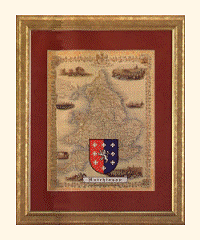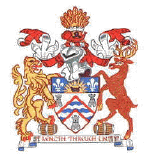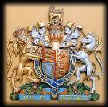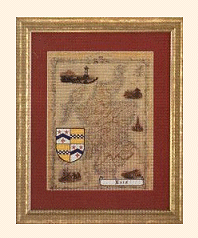




THE ANCIENT WILSFORD FAMILY OF DEVONSHIRE, AND THEIR LATER JAMESTOWN, JAMES CITY, COUNTY VIRGINIA COLONY: INCLUDES THE HANGING OF CAPTAIN THOMAS WILFORD AFTER BACON'S REBELLION AND CONFISCATION OF HIS PROPERTY BY GOVERNOR BERKELEY PRIOR TO THE AMERICAN REVOLUTION
RECORDS SHOW THE ANCIENT WILSFORD FAMILY RESIDED IN HARTRIDGE, PARISH OF CRANBROOK, COUNTY KENT, ENGLAND AND BEYOND.
EARLY HISTORY OF THE WILSFORD/WILFORD/WILLIFORDs
THE FAMILY OF MADELINE EBBY WILLEFORD (MY FATHER'S MATERNAL GENEALOGY)
(Genealogy And More History Available From Link)
Source: Williford and Allied Families, by William Bailey Williford: Published 1961; Available in the Newberry Library in Chicago: E7- W676.
Chapter One
The Williford Family
"The Williford family with which this history is concerned stems from an ancient English family whose name was spelled variously Wilford, Wilsford and Willford. These spellings, together with Welsford, Willaford, Willeford, Williford and Willsford, appear in records of Colonial Virginia until about 1700, after which date the patronymic was usually spelled Williford."
The first chapter relates the history of the family back to William Wilsford, date not specified, through several generations to James Wilsford who served as Alderman and Sheriff of London in 1499, and Sir James, Sir Thomas, and Cecily, their half-sister and sister, respectively, whose off-spring re-enters the Wilford family after Cecily marries Edwin Sandys, one of the leaders of the Marian exiles. "She apparently had accompanied her brother Thomas into exile, for her marriage occurred on 19 February 1558, some two years before Edwin Sandys returned to England."
"Edwin Sandys was born in North Lancashire in 1516 or 1519, a son of William and Margaret Sandys. He entered St. John's College, Cambridge, circa 1533. He was named Rector of the University in 1542, Master of St. Catherine's Hall in 1547, and Vice-Chancellor in 1553. Upon the death of Edward VI Sandys undestatingly took a stand on the side of Protestantism, preaching a sermon before the University and the Duke of Northumberland which committed him unequivocally. The sermon was printed, Mary was proclaimed, and Sandys was imprisoned in the Tower of London and at Marshalsea. He bore his affliction courageously and without compromise. Finally obtaining release, he crossed to the Continent and joined the group of exiles who were to be the forerunners in England of the church puritans. At Zurich, to which he had gone following the death of his first wife and their only child at Strasbourg, he lived for a time in the house of Peter Martur. Returning to England soon after Queen Mary's death, he became in fairly rapid succession Bishop of Worcester, then of London, and, in 1576, Archbishop of York."
"Sandys' personality and convictions brought him many enemies, but he accepted them serelely by saying that, 'when Gods cause cometh to hand, I forget what displeasure may follow.' He believed that celibacy was not required of the clergy, he opposed vestments and the making of the sign of the cross, he fought against the encroachments of secular government upon church property, and he opposed Queen Elizabeth I on the subjuect of images. He was criticized for devising to his eldest son Scrooby Manor, a noble building situated on the great road to Scotland which had been given to the See of York. Withal, however, hew was admired and respected, and generally had the full support of Elizabeth. His great scholarship was evidenced in his sermons, his translations for the Bishop's Bible, his various pastoral epistles and other letters, and in his founding ot the Hawkshead Grammar School."
"Edwin Sandys married (1) his cousin Mary Sandys of Essex, who, with their only child, James, died while he was in exile, 1554-1560. On 19 February 1558/59 he married (2) Cecely Wilford. The Archbishop died on 10 July 1588 and was buried in Southwell Minister, Notts. His widow survived until 5 February 1610 and was buried in Woodham Ferrars, Essex. According to her epitaph, 'She led a most Christian and holy life, carefully educated her children, wisely governed her familye, charitably relieved the poore, and was a true mirror of a Christian matron."
.......Sir Edwin Sandys, second son of Archbishop Sandys and the former Cecily Wilford, was born in Worcestershire on 9 December 1561. In 1571 he was entered at Merchant Taylor's School and thence was elected scholar of Corpus Christi College, Oxford, matriculating in September 1577. He was graduated B.A. on 16 October 1579, M.A. on 5 July 1583, and B.C.L. on 23 April 1589. He was elected fellow of Corpus early in 1580 and on 17 March 1581/82 his father presented him the prebend of Wetwang in York Cathedral. In 1589 he was admitted to Middle Temple as a student. (Inner Temple and Middle Temple have been schools of law for more than 600 years. With Gray's Inn and Lincoln's Inn, which lie outside the City of London, they comprise England's famous Inns of Court, comparable to the colleges of a great legal university.)
On 13 October 1586 Edwin Sandys entered Parliament as Member from Andover....Soon after the dissolution of Parliament in 1593 Sandys accompanied his friend George Cranmer on a three-year tour of the Continent, visiting France, Italy, and Germany. He remained abroad after Cranmer's return and was at Paris in 1599 when he commenced the writing of Europae Speculum. The book, remarkably tolerant for the time, was well received and eventually was translated into Italian, French, and Dutch.
Sandys returned to England in 1599 and in 1602 he resigned his prebend at Wetwamg. Next year he made his way to James VI of Scotland and accompanied him to England, where the latter subsequently ruled as James I. Sandys was knighted by the King at Charterhouse on 11 May 1603; on 12 March 1603 he was returned to James' first Parliament as Member for Stockbridge, Hampshire. .........Despite his other activities and interests in this period, Sir Edwin's main energies were devoted to the Virginia Company. He had been appointed a member of His Majesty's Council for Virginia on 9 March 1607. In 1617 he was chosen to assist Sir Thomas Smythe, the treasurer, in the management of the company. In this activity he warmly supported the request of the Leyden exiles to be allowed to settle in the company's dominion. It was largely owing to his influence that a patent was granted them. (A patent was an instrument making a conveyance or grant of public lands; also, the land so conveyed.)
On 28 April 1619 a combination of parties resulted in the almost unanimous election of Sandys to the treasurership, thereby making 1619 'a date to be remembered in the history of English colonisation.' In May he procured the appointment of a committee to codify the regulations of the company, to select a form of government for the Colony, to appoint magistrates and officers, and to define their functions and duties. Acting on the company's instructions, Governor George Yeardley of Virginia summoned an assembly of burgesses, which met in Bruton Parish church at James Towne on 30 July 1619. It was the first representative assembly to meet in America.
On 6 June 1619 Sandys obtained the company's sanction for the establishment of a missionary college at Henrico. Ten thousand acres were allotted for its maintenance, but the project subsequently was abandoned. During the years 1619, 1629, and 1621 the Virginia Company under Sandys provided and sent to Virginia 42 ships and 3,570 men and women, with provisions, cattle, and the like. It despatched the Mayflower from Plymouth, England, on 6 September 1620 with a load of 102 passengers; the vessel landed at Plymouth, Massachusetts, on 11 December. The company also sent to Bermuda nine ships and some 900 persons to settle there.
As the population of Virginia increased, and as prosperity waxed due to Sandys' enlightened policies of trade, the Treasurer's term of office expired on 27 May 1620. The company desired to reelect him, but King James angrily demanded that one of his own candidates be elected. He denounced the company as a seminary for a seditious Parliament and said that Sandys was his greatest enemy, concluding with the admonition, 'Choose the devil if you will, but not Sir Edwin Sandys.' Sandys withdrew his candidacy, but continued to sign receipts and transact other business for the company.
Sandys' position as leader of the popular party in Parliament alienated the support of the court. He was suspected of harboring designs to establish a republican and puritan state in America of which he and his friends would have complete control. On 16 June 1621 he was imprisoned in the Tower of London, but James found it politic to release him on 16 July. Three years later the King revoked the charter of the Virginia Company. The government of the Colony was assumed by the Crown, but the representative and other institutions established by Sandys remained to become the model for other American colonies.
.......Sir Edwin Sandys' wives were: (1) Margaret, daughter of John Eveleigh of Devonshire; (2) Anne, daughter of Thomas Southcott; (3) Elizabeth, daughter of Thomas Nevinson of Eastrey' and (4) Catherine, daughter of Sir Richard Bulkeley, Knight, of Anglesey. The first marriage produced one child, the third marriage also produced one child, and the fourth marriage produced twelve children. ...... Margaret Sandys, only child of Sir Edwin and Landy Margaret Sandys, married her cousin Sir Thomas Wilford, 2nd. He was a son of the Sir Thomas Wilford who was the only full brother of his wife's grandmother, Cicely (Wilford) Sandys.
The younger Sir Thomas was a stockholder in the Virginia Company of London and in the Bermuda Company of London. He was a Member of the first Parliament of CharlesI's reign, which included also his first cousins Sir Edwin Sandys, Sir Myles Sandys, and Henry Sandys, and his half-second cousin Sir Dudley Digges - the first four being grandsons, and the latter a great-grandson of Thomas Wilford of Cranbrook, Kent. Sir Thomas Wilford, 2nd, los his life and fortune while supporting Charles against Parliament at the beginning of England's Civil War.
The Wilford/Williford/Wilsford family was established in Colonial Virginia by the second son of Sir Thomas and Lady Margaret Wilford, who was known as Captain Thomas Wil(s)ford. It is likely that he emigrated from England because as a younger son he could not inherit from his father under England's laws of primogeniture and, also, his very existence was endangered by his family's loyalty to the Crown at a time of national crisis. It is entirely understandable that an ambitious and adventuresome young man would cast his lot with the Virginia colonists, especially one who undoubtedly had been influenced by his grandfather's liberal views. Thomas Wilford, of course, had more than ordinary ties with the struggling colony. His grandfather Sir Edwin Sandys and his uncle George Sandys had both served as treasurer of the Virginia Company; his cousin-in-law Sir Frances Wyatt had served as the Colony's second governor and later would be returned to office, while his distant cousin Edward Digges was to become governor at a later date.
"Captain Wilford settled in the Northern Neck, a peninsula between the Potomac and Rappahannock rivers, which soon became Northumberland County; years later Westmoreland County was created from most of the northwestern part of the peninsula. One of his neighbors and friends was a fellow emigrant from England whom he quite likely had known in their native land. This was John Washington, whose great-grandson was destined to become the first President of the United States and two of whose aunts had married relatives of Captain Wilford. That a close tie existed between the two men is borne out by numerous old records, one of the most interesting of which bears the signature of Wilford as a witness when Mrs. Frances Peyton granted to Washington a power of attorney. (Later she became Major Washington's third wife and he the third of her four husbands.)
On 13 April 1652 Captain Wilford was one of a group of Englishmen who affixed their signatures to a document affirming that, 'Wee whose names are published doo promise and engage ourselves to be true and faithfull to the Common wealth of England as it is now established without King or house of Lords.'
These men, like all colonists, received a grant of 50 acres of land for every person whom they could induce to immigrate to Virginia. One of the earliest grants to Thomas Wilford was made on 10 November 1651 when Governor Berkeley granted him 250 acres on Perries Creek in recognition of his persuading five persons to settle in the Colony and in payment for expenses which had been incurred in defraying their transportation.
His large land holdings, his official positions of importance, and his prominent connections notwithstanding, Captain Wilford seems to have made at least one enemy, as is attested by the (follows 3 entries in official records of Northumberland County).
"In 1676 Thomas Wilford was one of three prominent landowners who joined Nathaniel Bacon, Jr., in leading a rebellion against heavy taxes and Governor Berkeley's failure to suppress Indian massacres. Through their efforts James Towne was partially burned and Governor Berkeley was temporarily driven from the capital. At the peak of their success, however, Bacon died suddenly. The Governor promptly sent out raiding parties adn captured Major Chisholm, Thomas Hansford, and Captain Wilford. The latter two were taken before Berkeley's court on shipboard in the Eastern Shore area, where they were summarily condemned and later hanged. Major Chisholm escaped a similar fate only because he had died in prison 'of hard usage.' The property of all three was ordered confiscated.
"Governor Berkeley's vengeful course of execution and confiscation was so violent as to cause his recall by King Charles II, who remarked that, 'the old fool has killed more people in that naked country than I have done for the murder of my father.'
"A latter-day historian had this to say about one of Bacon's three lieutenants:
Captain Wilford, the third of the distinguished prisoners, was the second son of a knight who had lost his life and estate in the late King's quarrel with his parliament. 'He was a little man, yet he had a great heart, and was known to be no coward.' Bacon had made use of him with the Indians as an interpreter. In the recent fighting he had lost an eye but he made a jest of it, declaring that, as the governor had long ago promised him a hanging as being one of those who went out with Bacon in his first expedition against the Indians, it made no difference whether he had one eye or two eyes, for that in either case the governor would see him well guided to the place of executuion.
"Early Virginia records indicate that Captain Thomas Wilford was the father of at least two sons, Charles and Thomas Wilford 2nd. The latter son died some years before his father, for his will was probated on 11 September 1667. This document mentions three sons:
I Andrew Wilford
II James Wilford
III Thomas Wilford, 3rd.
Thos. 3rd died without issue in 1703.
Thomas Wilford, 2nd, and his wife Bridgett had immigrated to Virginia in 1653. They settled near his father in that part of Northumberland County which later became Washington Parish of Westmoreland County. Mrs. Wilford apparently died within a few years, for records indicate that her husband took as his second wife Mrs. Margaret Browne. The latter seems to have lived but a short time after the marriage, for on 24 February 1663/64 the Court of Westmoreland County, '...doth Ordr (at Tho. Wilsford's peticon) that Major John Washington shal be guardian to Sarah Browne, Daughter of Mrs. Margaret Browne als Wilsford, late wife of Thom: Wilsford, Dureing ye time she shall continue in ye Country. And that she shall be sent to her Uncle Mr. Richard Romney in barbados with ye first opertunity according to her mother's desire...'
Andrew Williford, son of Thomas Wilford, 2nd, lived in Westmoreland County upon the plantation which he had inherited from his father. He was the father of John Williford of Isle of Wight County, whose estate was appraised on 12 February 1746. The appraisal is signed by Elizabeth Williford, apparently the widow, who is believed to have been before marriage a Miss King of Virginia.
"Among the children of John and Elizabeth Williford was John Williford, 2nd, of Isle of Wight (later Southampton) County. He married Mary, daughter of Robert Johnson, 2nd, of Southampton County."




